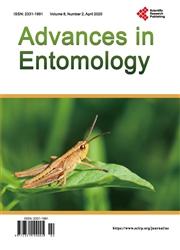Comparative Morphometry of the Sitophilus zeamais Motschulsky Populations (Coleoptera: Curculionidae) Infesting Yellow Maize in Four West African Countries
引用次数: 0
Abstract
Sitophilus zeamais is a primary pest of stored maize, which can cause quality and quantity losses. Maize is cultivated in several West African countries where different agro-climatic and agro-ecological conditions exist. These conditions could influence the Sitophilus zeamais morphology. Thus, the purpose of this study is to identify the Sitophilus zeamais morphological groups in the four countries. This was carried out through the morphometric study of 30 male Sitophilus zeamais individuals taken from the yellow maize in each country, by measuring with a binocular magnifying glass, 16 variables of the different tagmas belonging to the insect. Subsequently, statistical analyses were firstly carried out with the raw measurements, such as the principal component analysis, in order to extract the contribution of the variables on each factorial axis and to visualise the correlations between the variables. Taking the case of the transformed measurements, in addition to the principal component analysis, a discriminant factorial analysis was carried out to find out the best factor for gathering individuals according to their morphology, a confusion matrix to summarise the individual’s reclassification in order to deduce the good and bad classification rates, and an ascending hierarchical classification which consists of gathering the individuals according to their similarity and separating them according to their dissimilarity using the truncation method. Therefore, five morphological groups were identified. However, the existence of these morphological groups would not be linked to agro-ecological, climatic conditions and to the geographical remoteness between countries. How to cite this paper: Sarr, A.G.R.J., Dia, C.A.K.M., Diome, T. and Sembene, P.M. (2022) Comparative Morphometry of the Sitophilus zeamais Motschulsky Populations (Coleoptera: Curculionidae) Infesting Yellow Maize in Four West African Countries. Advances in Entomology, 10, 85-98. https://doi.org/10.4236/ae.2022.101007 Received: September 23, 2021 Accepted: January 3, 2022 Published: January 6, 2022 Copyright © 2022 by author(s) and Scientific Research Publishing Inc. This work is licensed under the Creative Commons Attribution International License (CC BY 4.0). http://creativecommons.org/licenses/by/4.0/ Open Access A. G. R. J. Sarr et al. DOI: 10.4236/ae.2022.101007 86 Advances in Entomology西非四国黄玉米侵染玉米象(鞘翅目:斑蛾科)种群形态比较
玉米象是贮藏玉米的主要害虫,可造成质量和数量损失。玉米在西非几个国家种植,这些国家存在不同的农业气候和农业生态条件。这些条件都可能影响玉米象的形态。因此,本研究的目的是鉴定四个国家的玉米象形态学类群。该研究是通过对每个国家的30只雄性玉米象个体进行形态计量学研究,通过使用双筒放大镜测量属于该昆虫的不同标记的16个变量。随后,首先使用原始测量进行统计分析,例如主成分分析,以便提取每个因子轴上变量的贡献,并可视化变量之间的相关性。以变换后的测量结果为例,除主成分分析外,还进行了判别析因分析,以根据个体的形态找出收集个体的最佳因子,并用混淆矩阵总结个体的重新分类,以推断出好的和坏的分类率;采用逐级递进的分类方法,根据个体的相似度进行聚类,根据个体的不相似度进行截断分离。因此,鉴定出5个形态学类群。然而,这些形态群体的存在与农业生态、气候条件和国家间地理位置的偏远无关。引用本文:Sarr, A.G.R.J, Dia, C.A.K.M, Diome, T. and Sembene, pm .(2022)西非4国黄玉米侵染玉米象(鞘翅目:斑蚊科)的比较形态测定。昆虫学进展,10,85-98。https://doi.org/10.4236/ae.2022.101007收稿日期:2021年9月23日收稿日期:2022年1月3日出版日期:2022年1月6日版权所有©2022 by作者和Scientific Research Publishing Inc。本作品采用知识共享署名国际许可协议(CC BY 4.0)。http://creativecommons.org/licenses/by/4.0/ Open Access A. G. R. J. Sarr等。DOI: 10.4236/ae.2022.101007 86昆虫学进展
本文章由计算机程序翻译,如有差异,请以英文原文为准。
求助全文
约1分钟内获得全文
求助全文

 求助内容:
求助内容: 应助结果提醒方式:
应助结果提醒方式:


